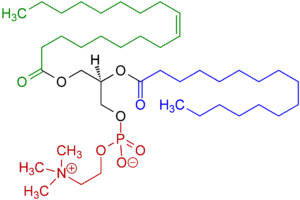Biosurfactant
Biosurfactant usually refers to surfactants of microbial origin.[1] Most of the bio-surfactants produced by microbes are synthesized extracellularly and many microbes are known to produce bio-surfactants in large relative quantities.[2] Some are of commercial interest.[3]
Examples

Common biosurfactants include:
- Bile salts are mixtures of micelle-forming compounds that encapsulate food, enabling absorption through the small intestine.[4]
- Lecithin, which can be obtained either from soybean or from egg yolk, is a common food ingredient.
- rhamnolipids, which can be produced by some species of Pseudomonas, e.g., Pseudomonas aeruginosa.[5]
- Sophorolipids are produced by various nonpathogenic yeasts.
- Emulsan produced by Acinetobacter calcoaceticus.[3]
Microbial biosurfactants are obtain by including immiscible liquids in the growth medium.[6]
Applications
Potential applications include herbicides and pesticides formulations, detergents, healthcare and cosmetics, pulp and paper, coal, textiles, ceramic processing and food industries, uranium ore-processing, and mechanical dewatering of peat.[6][1][2]
Oil spill remediation
Biosurfactants enhance the emulsification of hydrocarbons, thus they have the potential to solubilise hydrocarbon contaminants and increase their availability for microbial degradation.[7][8] These compounds can also be used in enhanced oil recovery and may be considered for other potential applications in environmental protection.[9]
References
- Mulligan, Catherine N. (2005). "Environmental applications for biosurfactants". Environmental Pollution. 133 (2): 183–198. doi:10.1016/j.envpol.2004.06.009. PMID 15519450.
- Ron, Eliora Z.; Rosenberg, Eugene (2001). "Natural roles of biosurfactants. Minireview". Environmental Microbiology. 3 (4): 229–236. doi:10.1046/j.1462-2920.2001.00190.x. PMID 11359508.
- Gutnick, D. L.; Bach, H. (2000). "Engineering bacterial biopolymers for the biosorption of heavy metals; new products and novel formulations". Applied Microbiology and Biotechnology. 54 (4): 451–460. doi:10.1007/s002530000438. PMID 11092618.
- Bhagavan, N.V.; Ha, Chung-Eun (2015). "Gastrointestinal Digestion and Absorption". Essentials of Medical Biochemistry. pp. 137–164. doi:10.1016/B978-0-12-416687-5.00011-7. ISBN 9780124166875.
- Oliveira, F. J. S.; Vazquez, L.; de Campos, N. P.; de França, F. P., Production of rhamnolipids by a Pseudomonas alcaligenes strain. Process Biochemistry 2009, 44 (4), 383-389
- Desai, Jitendra D.; Banat, Ibrahim M. (1997). "Microbial production of surfactants and their commercial potential". Microbiology and Molecular Biology Reviews. 61: 47–64. doi:10.1128/.61.1.47-64.1997.
- Rosenberg E, Ron EZ (August 1999). "High- and low-molecular-mass microbial surfactants". Appl. Microbiol. Biotechnol. 52 (2): 154–62. doi:10.1007/s002530051502. PMID 10499255.
- Del'Arco JP, de França FP (2001). "Influence of oil contamination levels on hydrocarbon biodegradation in sandy sediment". Environ. Pollut. 112 (3): 515–9. doi:10.1016/S0269-7491(00)00128-7. PMID 11291458.
- Shulga A, Karpenko E, Vildanova-Martsishin R, Turovsky A, Soltys M (1999). "Biosurfactant enhanced remediation of oil-contaminated environments". Adsorpt. Sci. Technol. 18 (2): 171–176. doi:10.1260/0263617001493369.